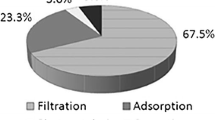Abstract
Nowadays, there is an amplified interest in maintaining suitable indoor air quality (IAQ). Besides a wide range of available interventions, air cleaners are considered a valuable tool, since based on inexpensive and easily implementing technologies to improve IAQ. The purpose of this work is to combine the TiO2-photocatalysis with the electrostatic and adsorption processes, in order to improve efficiency and reliability. A TiO2-photocatalytic oxidation combined with an electrostatic filter has been studied. Nitrogen oxides reduction and degradation of many VOC over different catalyst support were monitored jointly with CO and CO2 production. The coupling of photocatalysis with an external electric field enhances efficiency of the process. The choice of materials with diversified adsorptive characteristics plays an important role in the durability of the process over time.








Similar content being viewed by others
References
Arana J et al (2003) TiO2 activation by using activated carbon as a support: part I. Surface characterisation and decantability study. Appl Catal B Environ 44:161–172
Bulanin KM, Lavalley JC, Tsyganenkot AA (1995) Infrared study of ozone adsorption on TiO2 (Anatase). J Phys Chem 99:10294–10298
Chang, J.-S., Lawless, P. A. & Yamamoto, T., 1991. Corona discharge processes. IEEE Transactions on Plasma Science 1152–1166.
Chen M, Jin L, Liu Y, Guo X, Chu J (2014) Decomposition of NO in automobile exhaust by plasma-photocatalysis synergy. Environ Sci Pollut Res 21:1242–1247
Fann N et al (2012) Estimating the national public health burden associated with exposure to ambient PM2.5 and ozone. Risk Anal 32:81–95
Fava, G. & Pierpaoli, M., 2015a. A hybrid photocatalytic-electrostatic reactor for nitrogen oxides removal. American Journal of Environmental Engineering and Science 7–13.
Fava G, Pierpaoli M (2015b) Volatile organic compounds removal in a hybrid photocatalytic-electrostatic reactor. Am J Environ Eng Sci 2:14–17
Fujishima A, Rao NT, Tryk DA (2000) Titanium dioxide photocatalysis. J Photochem Photobiol C: Photochem Rev 1:1–21
Geoffrey, B. & Ian, G., 2011. Interfacial science: an introduction. s.l.:OUP Oxford.
Gunschera J, Markewitz D, Bansen B, Salthammer T, Ding H (2016) Portable photocatalytic air cleaners: efficiencies and by-product generation. Environ Sci Pollut Res 23(8):7482–7493
Guo YF, Ye DQ, Chen KF, He JC, Chen WL (2006) Toluene decomposition using a wire-plate dielectric barrier discharge reactor with manganese oxide catalyst in situ. J Mol Catal A Chem 245(1):93–100
Haiqiang W, Zhongbiao W, Weirong Z, Baohong G (2007) Photocatalytic oxidation of nitrogen oxides using TiO2 loading on woven glass fabric. Chemosphere 66(1):185–190
Henderson MA (2011) A surface science perspective on photocatalysis. Surf Sci Rep 66(6–7):185–297
Hoffmann MR, Martin ST, Choi W, Bahnemann DW (1995) Environmental applications of semiconductor photocatalysis. Chem Rev 95:69–96
Hüsken, G., Hunger, M., Ballari, M. M. & Brouwers, H. J. H., 2009. The effect of various process conditions on the photocatalytic degradation of NO. In: Nanotechnology in Construction 3. s.l.: Springer Berlin Heidelberg, pp. 223–229
Jacoby A et al (2012) Heterogeneous photocatalysis for control of volatile organic compounds in indoor air. J Air Waste Manage Assoc 46:891–898
Jinze L, Lizhong Z (2013) Highly efficient indoor air purification using adsorption-enhanced photocatalysis-based microporous TiO2 at short residence time. Environ Technol 34:1447–1454
Jo WK, Yang CH (2009) Feasibility of a tandem photocatalytic oxidation–adsorption system for removal of monoaromatic compounds at concentrations in the sub-ppm-range. Chemosphere 77(2):236–241
Kadoya K, Matsunaga N, Nagashima A (1985) Viscosity and thermal conductivity of dry air in the gaseous phase. J Phys Chem Ref Data 14:947–970
Linsebigler AL, Lu G, Yates JT (1995) Photocatalysis on TiO2 surfaces: principles, mechanisms, and selected results. Chem Rev 95(3):735–758
Metts T, Batterman S (2006) Effect of VOC loading on the ozone removal efficiency of activated carbon filters. Chemosphere 62:34–44
Obee TN, Brown RT (1995) TiO2 photocatalysis for indoor air applications: effects of humidity and trace contaminant levels on the oxidation rates of formaldehyde, toluene, and 1,3-butadiene. Environ Sci Technol 29:1223–1231
Ogata A, Ito D, Mizuno K, Kushiyama S, Yamamoto T (2001) Removal of dilute benzene using a zeolite-hybrid plasma reactor. IEEE Trans Ind Appl 37(4):959–964
Parker, K., 2012. Applied electrostatic precipitation. s.l.: Springer Science & Business Media
Vincent B et al (2014) Formation of indoor nitrous acid (HONO) by light-induced NO2 heterogeneous reactions with white wall paint. Environ Sci Pollut Res 21:9259–9269
Viner AS, Lawless PA, Ensor DS, Sparks LE (1992) Ozone generation in DC-energized electrostatic precipitators. IEEE Trans Ind Appl 28:504–512
Woan K, Pyrgiotakis G, Sigmund W (2009) Photocatalytic carbon-nanotube–TiO2 composites. Adv Mater 21:2233–2239
Xiao G, Xu W, Wu R, Ni M, Du C, Gao X, Cen K (2014) Non-thermal plasmas for VOCs abatement. Plasma Chem Plasma Process 34(5):1033–1065
Yu QL, Brouwers HJH (2009) Indoor air purification using heterogeneous photocatalytic oxidation. Part I: experimental study. Appl Catal B Environ 92(3):454–461
Yu KP, Lee GWM (2007) Decomposition of gas-phase toluene by the combination of ozone and photocatalytic oxidation process (TiO2/UV, TiO2/UV/O3, and UV/O3). Appl Catal B Environ 75:29–38
Author information
Authors and Affiliations
Corresponding author
Additional information
Responsible editor: Constantini Samara
Rights and permissions
About this article
Cite this article
Pierpaoli, M., Giosuè, C., Ruello, M.L. et al. Appraisal of a hybrid air cleaning process. Environ Sci Pollut Res 24, 12638–12645 (2017). https://doi.org/10.1007/s11356-016-7880-x
Received:
Accepted:
Published:
Issue Date:
DOI: https://doi.org/10.1007/s11356-016-7880-x




